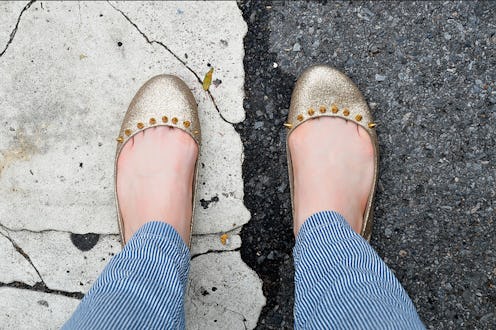Fashion
9 Ways To Handle An Unruly Blister

Spring is sandal season, which means it's shoes without socks season... which means it's blister season. And the question of how to get rid of blisters is once again at the forefront of your woes. Oh, blister season. That time of year when your gentle bare feet, after months of being swaddled in kind woolen socks, are subjected to the rough leather and cloth of stiff sandals and sneakers, only to be left chafed and red and blistered at the end of the day. The only thing worse than getting blisters on the bottom of your feet is not knowing what to do with blisters on your feet. So how do you treat a blister at home?
Sure, you can try to prevent blisters by buying more comfortable shoes, but we all know that's not going to happen. Sometimes you can't say no to a cute pair of sandals, even if you know just from looking at them that they'll wreak havoc on your insteps. Besides, you can get blisters from even the most comfortable shoes, especially when you're first breaking them in. (I'm looking at you, Birkenstocks.)
My first instinct after getting a blister is to hack away at it with a pair of tweezers, but after plenty of error and some trial and lots of fighting my instincts, I've figured out a better way (and believe me when I say I know a thing or two about blisters). If you think your feet don't look great with a blister, think about how gross they'll look with an infected blister... not to mention how much more painful they'll be! So here are nine tips to handling unruly blisters without causing more damage.
1. Let It Be
The best thing you can do when you get a blister is leave it alone, and trust me when I say I know how hard this can be. The Mayo Clinic recommends throwing a bandage over it and letting the blister heal itself so that you don't risk any infection. If it's not too painful or inconvenient, this is definitely the safest way to get rid of a blister.
2. A.B.C. — Always Be Cleaning
Well, maybe not always. But making sure you keep your blister dirt-free is important, especially if you're going to end up popping it (but more on how to do that later). Don't rub your blister with iodine or rubbing alcohol. This is a case where good old soap and water will work just fine.
3. Try Aloe Vera
Lily of the Desert Aloe Vera Gel, $9, A mazon
When you've got a blister that's bothering you, you can slather on some aloe vera gel. Aloe vera has astringent properties, which will help with preventing infection and keeping the blister clean, and the cooling sensation feels nice when your feet are burning.
4. Soak Your Feet
There are three main benefits to soaking your feet. It'll keep the blister clean. It'll soften the skin around the blister so it drains a little quicker. And it feels really nice, especially after a long day of wearing uncomfortable footwear. Throw in a little epsom salt into some warm water, and relax.
5. If You Do Pop A Blister, Have The Proper Tools
Sometimes, you just have to pop a blister, especially if it's on the bottom or arch of your foot and it's preventing you from walking properly. So if you're going to go that route, make sure you have the proper supplies: iodine or rubbing alcohol, cotton pads, a needle, antibiotic ointment, and bandages. This is when making sure your blister is clean — again, with soap and water only — is especially crucial.
Try: Be Smart, Get Prepared Blister Relief Kit, $7, Amazon
6. Do Not Remove The Loose Skin
If you're going to pop the blister, clean the needle with rubbing alcohol or iodine first, then prick the sides of the blister to let the fluid drain out. Do not pick the skin off your blister after you pop it. Let me repeat that, because it's really important. Don't pick that loose skin off the top of a popped blister because if you do, you'll leave quite an opening for infections. Leaving that layer of skin will help with the healing process, too.
7. Clean Bandages Are Your Best Friends
Once you're done with the needle, apply some antibiotic ointment and put a bandage on it. Make sure it's loose enough that you're not losing blood flow or anything. May I recommend a stylish Hello Kitty Band-Aid, so you feel a little bit better about your blister?
8. Watch For Infections
After you pop a blister, keep an eye on it to make sure it doesn't become infected. Signs of infection will include (and this is kind of gross, so apologies in advance) pus, more pain than before or more redness, or, at worst, a fever. If you get any of these symptoms, it might be time to seek professional medical attention. You can prevent infections by changing the bandage daily and applying an antibiotic ointment.
9. Prevention Is The Best Cure
Band-Aid Active Friction Block Stick, $22, Amazon
I know this is kind of lame advice, but avoiding blisters is really the best way to cure them. If there's a certain spot where you know you're prone to get blisters, invest in some moleskin bandages and slap one one before putting on a pair of new shoes. If you're not a fan of walking around with bandages on your feet, you can also try something like Band-Aid Active Friction Block Stick, which provides a layer of protection between your skin and the shoe.
Images: Stacie/Flickr; wyyrachel, gin_fit, caylahruth/Instagram; Giphy; Courtesy Brands